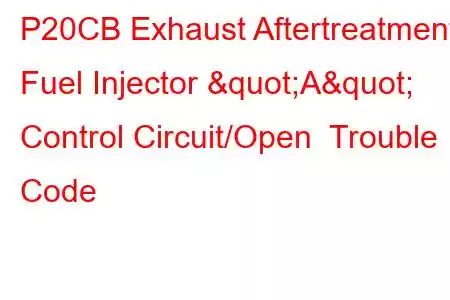P20CB Exhaust Aftertreatment Fuel Injector A Control Circuit/Open
OBD-II Trouble Code Technical Description
Exhaust Aftertreatment Fuel Injector A Control Circuit/Open
What does that mean?
This diagnostic trouble code (DTC) is a generic powertrain code and applies to many OBD-II vehicles (1996-newer). That may include but is not limited to vehicles from Mercedes Benz, Sprinter, GMC, Chevrolet, Ford, etc. Although generic, the exact repair steps may vary depending on year, make, model and powertrain configuration.
If your diesel powered vehicle has stored a code P20CB, it means that the powertrain control module (PCM) has detected no voltage in the control circuit for the exhaust aftertreatment fuel injector, designated A. The designation A indicates that multiple reductant injectors are in use.
The exhaust aftertreatment system (also called selective catalyst reduction system) is used to enhance the capabilities of the exhaust catalyst system. It may consist of one or more of these items; diesel oxidation catalyst, diesel particulate filter, reductant injection system, ammonia slip catalyst, and a nitrogen oxide (NOx) trap.
Among other things, exhaust aftertreatment systems (EAS) are responsible for the injection of reductant compound/diesel exhaust fluid (DEF) into the exhaust in front of the diesel particulate filter, NOx trap, and/or the catalytic converter via an automated fluid storage and injection system. Introducing DEF into the catalyst system promotes filtration element longevity and allows fewer harmful exhaust emissions to be released into the atmosphere.
The EAS and catalyst systems are monitored and controlled by either the PCM or a stand-alone controller (which interacts with the PCM). The controller monitors the O2, NOx, and exhaust temperature sensors (as well as other inputs) to determine the appropriate time for DEF (reductant) injection. DEF injection must be performed at the appropriate instant and in precise measure in order to maintain an exhaust temperature that is within acceptable parameters and to optimize pollutant filtration.
If the PCM detects no voltage on the control circuit for the EAS fuel injector, a code P20CB will be stored and a malfunction indicator lamp may be illuminated.
What is the severity of this DTC?
A stored code P20CB should be considered severe and addressed as quickly as possible. The EAS system may be damaged as a result of the conditions which contributed to the code P20CB being stored.
What are some of the symptoms of the code?
Symptoms of a P20CB trouble code may include:
Diminished engine performance Excessive black smoke from vehicle exhaust Reduction in fuel efficiency Other EAS/SCR related codesWhat are some of the common causes of the code?
Causes for this code may include:
Bad EAS fuel injector Open or shorted circuits in the EAS fuel injection control circuit Insufficient DEF in the EAS reservoir Bad EAS controller/PCM or programming errorWhat are some P20CB troubleshooting steps?
A diagnostic scanner, a digital volt/ohmmeter (DVOM), and a source of vehicle specific diagnostic information will be required to diagnose a code P20CB.
Locating a technical service bulletin (TSB) that matches the vehicle year, make, and model; as well as the engine size, code/s stored, and symptoms exhibited, could yield helpful diagnostic information.
I like to begin my diagnosis with a visual inspection of the EAS wiring harnesses and connectors. Burnt or damaged wiring and or connectors should be repaired or replaced before proceeding.
I would continue by plugging the scanner into the vehicle diagnostic connector and retrieving all stored codes and pertinent freeze frame data. Consider writing this information down before clearing the codes. Test drive the vehicle until the PCM either enters readines
Read: 23


